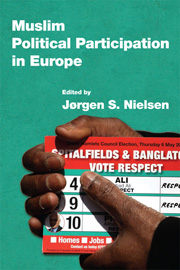1 - Introduction
Published online by Cambridge University Press: 05 October 2013
Summary
In the media and among politicians in recent years it has been common to point to tendencies among Muslim communities which seek to either isolate themselves from the surrounding society or seek actively to position themselves in public opposition to it. This especially happens around national elections when isolationist tendencies are interpreted as a sign of a deep incompatibility between Islam and democracy while oppositional voices are interpreted as proof of such incompatibility. At several recent general elections in the United Kingdom, party election posters in some districts of Muslim residential concentration, certain districts of, for example, Birmingham and Bradford, have been defaced with slogans calling on Muslims not to vote in a kafir system. While John Bowen's study on Islam in France (Bowen 2010) does not directly investigate Muslim activity during elections his account identifies a sector, especially among young Muslims, that withdraws from society into their own religio-cultural enclaves. At the other end of the spectrum have been the instances of political parties seeking to attract a Muslim vote (see Didero and Peace in this volume)
- Type
- Chapter
- Information
- Muslim Political Participation in Europe , pp. 1 - 14Publisher: Edinburgh University PressPrint publication year: 2013



